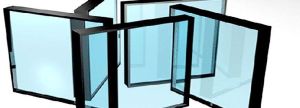
Toughened or Tempered Glass
Tempered glass is made from normal annealed glass via a thermal tempering process in which the glass is subjected to heat till its softening point and then rapidly cooled. This gives the glass its strength 4 to 5 time compare to normal glass. Characteristics of Toughened Glass Strength: Toughened Glass is four to five times stronger than its equivalent thickness of normal annealed float sheet glass. High Thermal Shock Strength: Tempered glass provides greater thermal strength. It offers increased resistance to both sudden temperature changes and temperature differentials up to 240°C compared to normal annealed glass which can withstand temperature differentials up to 40°C only. Safety: Toughened glass is very difficult to break but even on breakage it will break into small, relatively harmless fragments. This substantially reduces the likelihood of injury to people as there are no jagged edges or sharp corners which are normal in the case of breakages of annealed glass. It is considered as a safety glazing.
...more
Lacquered Glass
Lacquered glass, coloured and opaque in appearance, and is produced by depositing and then baking a highly durable and resistant lacquer to one side of the glass.Coloured glass wall panelling can add warm or fresh tones to interior decor, with all-over brilliance of glass. Rubine's colored and lacquered glass, can be used for a range of applications like table tops, wardrobes, kitchens counters, home pillar cladding, paneling for walls, shower wall panels, etc. Lacquered glass can be used extensively for modern interior design in kitchens, living rooms, office spaces etc. Coloured lacquer with the brilliance of glass, giving your interiors a fresh new look. It's very easy to maintain and perfect for a variety of applications. So just choose the colour to match the mood you desire and let the creativity flow!
...more
INSULATING GLASS OR DOUBLE GLAZING
Insulated glass is a prefabricated unit made of two or more glass panes, which have been separated by an air gap and edge-sealed together. This is also known as double glazed unit (DGU) or insulated glass unit (IGU) Benefits Insulated glass saves on heating and cooling, by reducing air to heat transfer. The enclosed layer of air makes the insulating capability about twice that of monolithic glass. Because of this, the load on the air conditioning is greatly reduced. The use of heat absorbing or heat reflective glass will further reduce the load on the cooling system.
...more
Heat Strengthened Glass
Heat strengthened glass is similar to tempered glass except that after heating the glass in a furnace as in the case of tempered glass, the cooling is done at a much slower pace. The heating temperature remains nearly the same for both processes. The residual stress on the edge and the glass surface differ in both cases with tempered glass having a higher level of stress. Due to the relatively lower rate of cooling during the strengthening process, heat strengthened glass develops less stress as compared to fully tempered glass.
...more
Frosted Glass

ceramic printed glass
Ceramic printed on glass is done with special enamels which are applied to glass before it is tempered. During the heating process in tempering this enamel fuses into the glass and becomes a monolithic construction. It is thus, a permanent printing or coating and has all technical/mechanical characteristics of the unprinted glass. It is lifelong and does not deteriorate with weather, detergents, normal acids or alkalis.
...moreBe first to Rate
Rate This